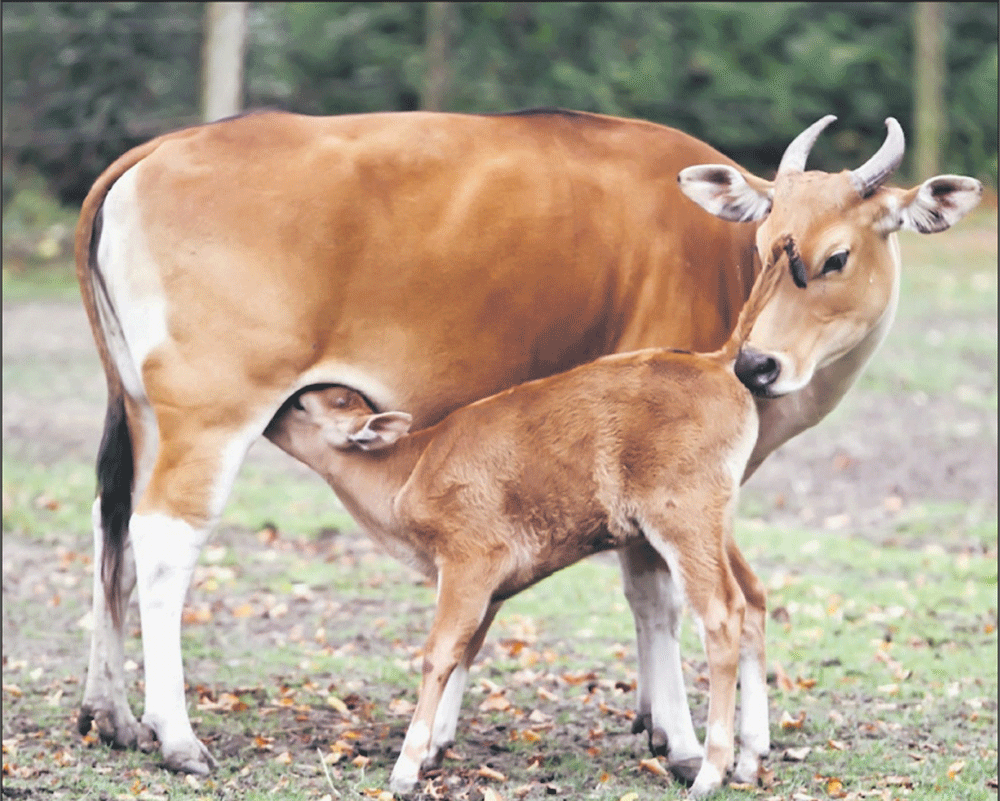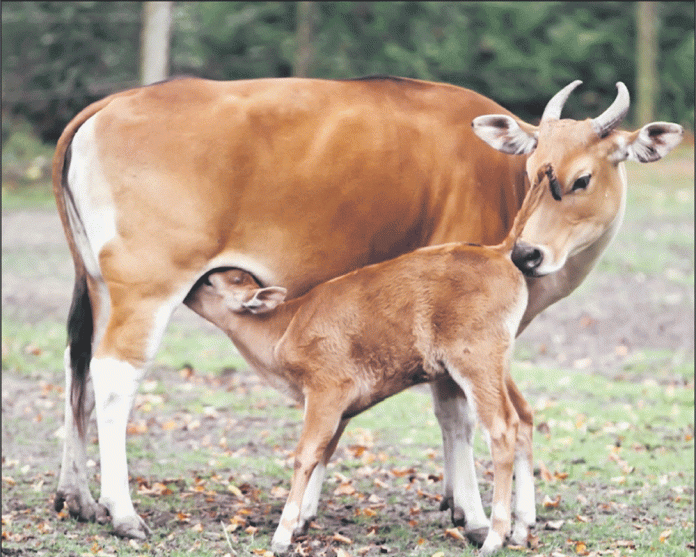
The banteng calf is suckled up to an age of 16 months.
MAY Chinese New Year 2021 be a less stressful year than 2020. I wish and hope for all readers that the Coronavirus disease subsides and that life can get back to as near normal as possible. For those born in the Year of the Ox, no doubt your extremely hard work and determination in solving immediate problems together with your strong nature will earn you good things and high esteem.
Bornean Banteng
This breed of oxen is generally known as banteng (Bos javanicus lowi) but also as tembadau or the Bornean wild ox. It is closer to the gaur (Bos gaurus) than to other banteng species. Various subspecies of the Bornean banteng exist in domesticated cattle.
Alfred Russel Wallace recorded an insightful observation of domesticated banteng on Bali in his book, ‘The Malay Archipelago’, first published in 1869. He noted that, “They are large and handsome animals, of a light brown colour, with white legs and a conspicuous oval patch behind of the same colour. Wild cattle of the same race are said to be still found in the mountains.”
Interbreeding amongst cattle species led to the domesticated banteng of today.
Distribution
The Bornean wild banteng is thinly distributed in Northern Borneo (Sabah) and in North Eastern and South Western Kalimantan. Banteng became extinct in Peninsular Malaysia in 1950 and in Sarawak in 1980. A wild herd of between 15 and 20 cattle were spotted in the Maliau Basin Conservation Area in Sabah (Hazebroek 2004). This species of animal is now classified as Endangered on the International Union for Conservation of Nature (IUCN) Red List with its numbers decreasing over the last 50 years by over 50 per cent. Although a legally protected species of wildlife, they are systematically poached for food, traditional medicines, and their horns. Contributing greatly to their decline has been man’s encroachment on their habitats through deforestation and a change in land use to oil palm plantations and land fragmentation, together with their susceptibility to disease.
Cave art discovered in East Kalimantan has exhibited images of wild banteng dating back to over 12,000 years. Banteng bones and teeth have been found in Javanese caves dating to prehistoric hunters’ times.
Distinctive features
A wild banteng’s head to body measurements are between 1.9 and 2.3 metres with cows weighing between 500kg and 670kg, and bulls from 600kg to 800kg. The bulls are coloured dark brown to black and females pale brown or chestnut red. Their legs are quite distinctive by their white ‘stockings’ on the lower parts of their legs from just above the knees extending to their hoofs. There is a big white patch on their rumps, which serves as a guide in the dark for herds to stay together. This reminds me very much of the wild roe deer, in woodland near to my house in Somerset, UK, for they also sport a distinctive white rump patch to stay together at night time.
Both bulls and cow banteng proudly sport their horns, which are between 60cm and 75cm long with sharp tips. Females can breed at two years of age with a gestation period of nine to 10 months, giving birth to a single calf. The calf is suckled up to an age of 16 months. Males take slightly longer to reach sexual maturity at three years of age. Banteng can live for up to 26 years.
Feeding patterns
These animals are essentially herbivorous, foraging at night on bamboo shoots, flowers, fruit, grasses, leaves off lower shrubs, and sedges. During the rainy season, they tend to move to higher altitude forests, drinking water from standing pools but they can survive for several days without water during periods of drought. Frequently they visit salt licks and even drink sea water during the dry monsoon. Then, they have been observed to feed on seaweed!

Banteng bulls weigh between 600kg and 800kg. – Photo by Buyung Sukananda
Wild banteng are found in a variety of habitats in semi-evergreen forests and lower montane forests up to a height of 2,100 metres and on abandoned farmlands and grasslands. Like domestic taurine breeds, banteng take up to two to three hours to rest and ruminate during grazing times.
Behavioural characteristics
Found in herds of between five and 40 animals with a dominant bull, they are more active by night in areas occupied by humans. Timid, shy, and reclusive, they are highly alert and seek rest and shelter in dense forests. As they are difficult to approach, this may explain why numbers of sighted wild banteng are very confused. With a strong sense of smell, they can easily detect predators and when frightened they will stampede through the forests.
Prone to diseases
Parasitic diseases such as liver fluke and intestinal worms are major threats but they also suffer from bovine malignant catarrhal fever and skin diseases. They have a remarkable immunity to tick borne diseases. Birds can frequently be seen perched on their backs whilst pecking off ticks especially from their hindquarters.
Domestication
Banteng were domesticated in Java and on the Southeast Asian mainland as early as 4,520 years before the present. Very docile creatures, they can thrive even on the poorest of quality pasturelands. They are mainly reared for their meat but they are also used as draught animals in tasks such as ploughing paddy fields and drawing carts. On the island of Bali, 2.5 million domesticated banteng may be found. Sadly, in 1964, a viral disease destroyed up to 60 per cent of the banteng population in different locations in Bali.
Little is generally known about the Bornean banteng mainly because of their reclusiveness in inaccessible forest environments. More research is needed in this field with the use of remote night imaging cameras to determine more accurate numbers. One thing that we can take to our hearts is the fact that it is illegal to poach wild banteng.
They play a very important part in the Bornean forest ecosystem as their grazing controls scrub growth and their dung adds fertility to the soil, thereby supporting insects and animals further up the food chain to include birds. Unfortunately, because of man’s invasion and trespass upon their habitats, these wild banteng have become groups of highly inbred animals.
May all blessings be bestowed on those new born calves in the Year of the Ox and hopefully they can, too, look forward to a brighter future.
The post The Year of the Ox 2021 appeared first on Borneo Post Online.


